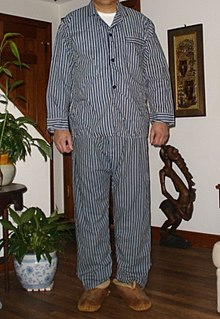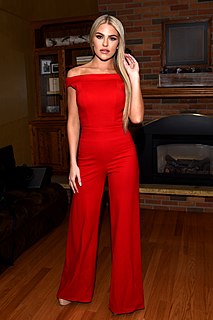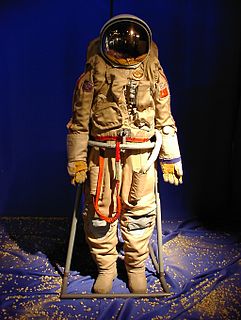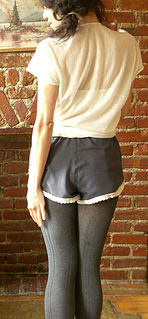
A space suit is a garment worn to keep a human alive in the harsh environment of outer space, vacuum and temperature extremes. Space suits are often worn inside spacecraft as a safety precaution in case of loss of cabin pressure, and are necessary for extravehicular activity (EVA), work done outside spacecraft. Space suits have been worn for such work in Earth orbit, on the surface of the Moon, and en route back to Earth from the Moon. Modern space suits augment the basic pressure garment with a complex system of equipment and environmental systems designed to keep the wearer comfortable, and to minimize the effort required to bend the limbs, resisting a soft pressure garment's natural tendency to stiffen against the vacuum. A self-contained oxygen supply and environmental control system is frequently employed to allow complete freedom of movement, independent of the spacecraft.

Nightwear – also called sleepwear, nightclothes, or nightdress – is clothing designed to be worn while sleeping. The style of nightwear worn may vary with the seasons, with warmer styles being worn in colder conditions and vice versa. Some styles or materials are selected to be visually appealing or erotic in addition to their functional purposes.

A jumpsuit is a one-piece garment with sleeves and legs and typically without integral coverings for feet, hands or head. The original jump suit is the functional one-piece garment used by parachuters.

The United States Astronaut Badge is a badge of the United States, awarded to military pilots, naval flight officers, navigators/combat systems officers, flight surgeons, and civilian pilots who have completed training and performed a successful spaceflight. A variation of the astronaut badge is also issued to civilians who are employed with the National Aeronautics and Space Administration as specialists on spaceflight missions. It is the least awarded qualification badge of the United States military.

A flight suit is a full-body garment, worn while flying aircraft such as military airplanes, gliders and helicopters. These suits are generally made to keep the wearer warm, as well as being practical, and durable. Its appearance is usually similar to a jumpsuit. A military flight suit may also show rank insignia. It is sometimes used as a combat uniform in close quarters battle or visit, board, search, and seizure situations, for its practicality.

An undershirt is an article of underwear worn underneath a dress shirt intended to protect it from body sweat and odors. Alternatively, it may be worn to protect the body from stiff or otherwise uncomfortable fabric that a person may be required to wear. It can have short sleeves or be sleeveless. The term most commonly refers to upper-body wear worn by males. This article of clothing typically has a low, round neckline that can be worn for athletic purposes.

An environmental suit is a suit designed specifically for a particular environment, usually one otherwise hostile to humans. An environment suit is typically a one-piece garment, and many types also feature a helmet or other covering for the head. Where the surrounding environment is especially dangerous the suit is completely sealed.

The Mercury space suit was a full-body, high-altitude pressure suit originally developed by the B.F. Goodrich Company and the U.S. Navy for pilots of high-altitude fighter aircraft. It is best known for its role as the spacesuit worn for all manned Project Mercury spaceflights.

Billionaire Boys Club and Ice Cream is an American and Japanese clothing retailer established by Pharrell Williams and Nigo, founder of clothing label BAPE. The lines consist of T-shirts, polos, sweatshirts, knits, denim, suits and shirts; outerwear in leather, down, cotton, and technical fabrics; hats, sneakers, underwear, socks and accessories. The items are produced in very limited quantities and are usually sold for high prices.

The Neutral Buoyancy Laboratory (NBL) is an astronaut training facility and neutral buoyancy pool operated by NASA and located at the Sonny Carter Training Facility, near the Johnson Space Center in Houston, Texas. The NBL's main feature is a large indoor pool of water, in which astronauts may perform simulated EVA tasks in preparation for upcoming missions. Trainees wear suits designed to provide neutral buoyancy to simulate the microgravity that astronauts would experience during spaceflight.
A mission patch is a cloth reproduction of a spaceflight mission emblem worn by astronauts and other personnel affiliated with that mission. It is usually executed as an embroidered patch. The term space patch is mostly applied to an emblem designed for a manned space mission. Traditionally, the patch is worn on the space suit that astronauts and cosmonauts wear when launched into space. Mission patches have been adopted by the crew and personnel of many other space ventures, public and private.

Tap pants are a form of lingerie designed for women, also known as side-cut shorts or dance shorts, and are similar to French knickers in appearance. As the name implies, they are a type of shorts, in that they cover the pelvic area and the upper part of the upper legs.

Clothing fetishism or garment fetishism is a sexual fetish that revolves around a fixation upon a particular article or type of clothing, a collection of garments that appear as part of a fashion or uniform, or a person dressed in such a garment.
A Maximum Absorbency Garment (MAG) is adult-sized diaper with extra absorption material that NASA astronauts wear during liftoff, landing, and extra-vehicular activity (EVA) to absorb urine and feces. It is worn by both male and female astronauts. Astronauts can urinate into the MAG, and usually wait to defecate when they return to the spacecraft. However, the MAG is rarely used for this purpose, since the astronauts use the facilities of the station before EVA and also time the consumption of the in-suit water. Nonetheless, the garment provides peace of mind for the astronauts.

Undergarments are items of clothing worn beneath outer clothes, usually in direct contact with the skin, although they may comprise more than a single layer. They serve to keep outer garments from being soiled or damaged by bodily excretions, to lessen the friction of outerwear against the skin, to shape the body, and to provide concealment or support for parts of it. In cold weather, long underwear is sometimes worn to provide additional warmth. Special types of undergarments have religious significance. Some items of clothing are designed as undergarments, while others, such as T-shirts and certain types of shorts, are appropriate both as undergarments and as outer clothing. If made of suitable material or textile, some undergarments can serve as nightwear or swimsuits, and some are intended for sexual attraction or visual appeal.

The thong is a garment generally worn as either underwear or as a swimsuit in some countries. It may also be worn for traditional ceremonies or competitions.

Proyekt Maslul is the Israeli version of the American reality show Project Runway. The show was filmed during the winter of 2008–2009 and premiered on June 17, 2009. The show features 13 Israeli designers who compete to become "the next big fashion designer". Alon Livne won Project Runway Israel.

Wearing underwear as outerwear is a fashion trend. Current examples include the display of thongs and bras in women's clothing, and the display of underpants under low-slung pants in men. As of 2009, the visible wearing of corsets had become fashionable, popularized by stage performers such as Lady Gaga and Rihanna. Wearing underwear as outerwear has historical antecedents in the display of undergarments in the sixteenth and seventeenth centuries.

Andrew Christian is an American men's underwear, swimwear, and sportswear manufacturer named after its founder, Andrew Christian.

A dudou—also known by other names—is a traditional Chinese form of the bodice, originally worn as an undershirt with medicinal properties. With the opening of China, it is sometimes encountered in Western and modern Chinese fashion as a sleeveless and backless halter-top blouse.


















